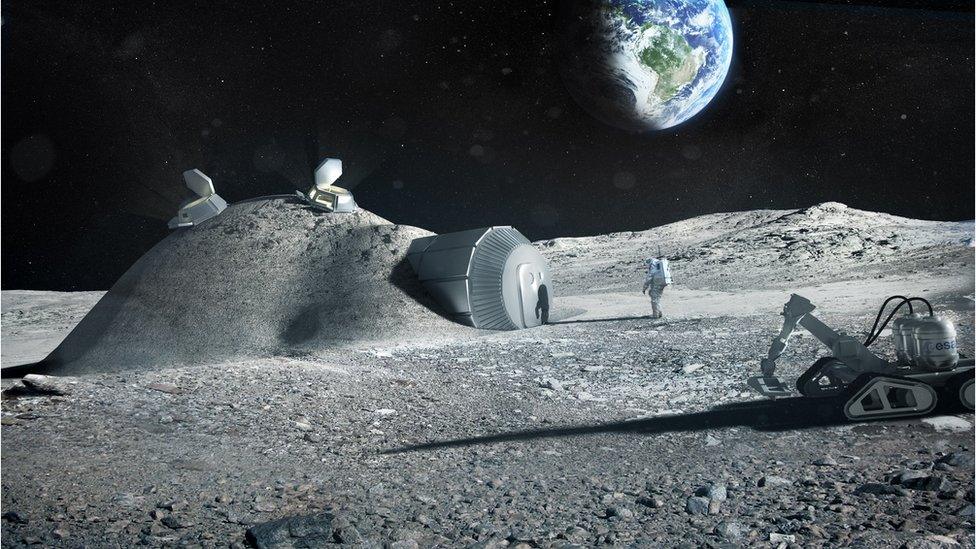Bezos floats 'national team' to build Moon lander
- Published

Bezos made the announcement at the International Astronautical Congress in Washington
Jeff Bezos has announced the formation of a "national team" that will aim to build the lander that will take astronauts back to the Moon in 2024.
Bezos' space company Blue Origin has teamed up with aerospace giants Lockheed Martin, Northrop Grumman and Draper to bid for the landing system.
The White House has set the ambitious goal of sending a man and a woman to the lunar South Pole within five years.
Bezos outlined the plan at a meeting in Washington DC.
The Amazon founder called the partnership "a national team for a national priority".
Nasa had originally planned to mount the Moon return mission in 2028. But earlier this year, Vice President Mike Pence announced the administration's plan to accelerate that timeline by four years.

Blue Origin unveiled the Blue Moon lander concept in May this year
"Ladies and gentlemen, that's just not good enough," Mr Pence said about the original schedule when announcing the 2024 target in March.
The programme has been named Artemis, after the sister of Apollo.
Blue Origin, a relatively new entrant in the human spaceflight sector, will lead the team, which is composed of companies with decades of experience building hardware for Nasa.
"We recognise that this project and the time frame that the nation is calling for is ambitious, very ambitious," Brent Sherwood, Blue Origin's vice president of advanced development programs was reported as saying by the Washington Post., external
Under existing plans, the lander would undock from a small space station in lunar orbit called Gateway. Nasa has previously said it wants a lander that's split into three separate parts, or stages - although it has left the door open to other designs and modes of getting to the lunar surface.
One stage is called the transfer vehicle or "tug". It carries the other two elements down from Gateway to a lower lunar orbit. Northrop Grumman would build this stage under the national team bid.
The development of the original Apollo lunar lander was led by Grumman Aircraft, which merged with Northrop Corporation in 1994 to form Northrop Grumman.

To the Moon and Beyond

Can America get back to the lunar surface by 2024? Read the article

Another stage, called the descent element, takes the crew from low lunar orbit to the surface. Blue Origin plans to build this part of the lander, which will incorporate the company's BE-7 engine that is currently being developed.
Finally, an ascent element blasts the astronauts back into lunar orbit. Lockheed Martin would develop this vehicle.
Cambridge, Massachusetts-based Draper will provide descent guidance and flight avionics (electronics systems). As the MIT Instrumentation Laboratory, the not-for-profit research organisation designed the Apollo Guidance Computer that helped astronauts manoeuvre safely to the lunar surface in the 60s and 70s.

Lockheed Martin has previously developed its own lunar lander concept
"Humankind's future will be determined by our ability to live and thrive beyond the Earth's surface. Leveraging the commercial sector with new, privately-funded space technologies and capabilities are critical elements of that future," said Dr Ken Gabriel, president and chief executive of Draper.
"Key among these capabilities is reuseable launch vehicles which lower the barrier of entry to the new space economy. The dawn of the Space Age was more than 50 years ago and driven only by government investments - today, industry is driving and daylight is here."
The national team bid will be in competition with other companies for the contracts to build the landing system. The winning bid could be announced in the coming months.
Mr Bezos was speaking at the 70th International Astronautical Congress in Washington DC., external
Follow Paul on Twitter., external
The Silicon Valley space race